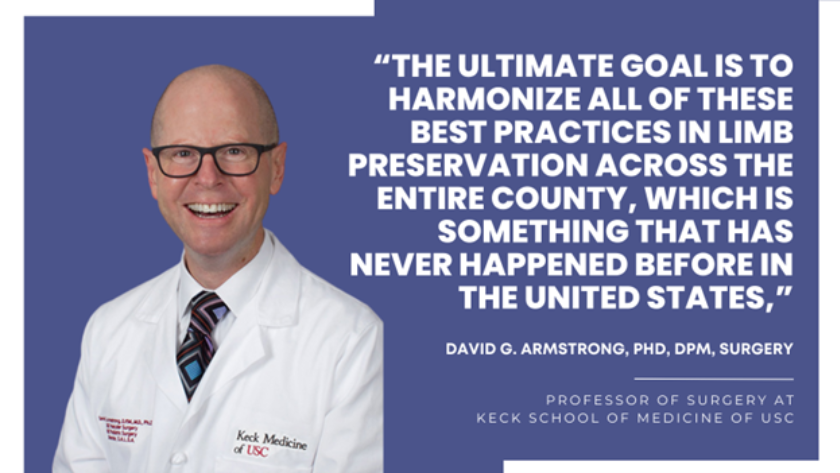SC CTSI grant jump-starts first-ever countywide limb preservation program
More than half of diabetic patients who get a below-the-knee amputation die within five years.

If untreated, chronic foot wounds threaten the limbs and lives of diabetic patients. High blood sugar associated with diabetes can lead to complications in sensation and circulation limit blood circulation needed to fight off foot infections, leading to diabetic foot ulcers. Many wounds become infected, leading to amputation. More than half of diabetic patients who get a below-the-knee amputation die within five years. This is the equivalent of all but the most aggressive cancers.
“Diabetes is more expensive in the United States in terms of direct costs than each of the five most expensive cancers,” said David G. Armstrong, DPM, MD, PhD Professor of Surgery at Keck School of Medicine of USC.
But clinician teams in Southern California are collaborating to beat those odds and save limbs.
The Los Angeles County Department of Health Services (DHS) is creating a system-wide Limb Preservation workgroup to protect more patients from the trauma of high-level amputation and allow them to live healthier lives. The multi-specialty, first-of-its-kind countywide program will bring clinician teams together to identify, grade, and treat diabetic foot ulcers and enhance follow-up care to prevent relapses, among other measures. This rapid, coordinated system could make the difference between many patients losing or saving a foot or leg.
Physicians involved with the program since its inception at Harbor UCLA in 2016 are excited to see its expansion, like Ashley Miller, DPM, Assistant Professor of Surgery at the UCLA David Geffen School of Medicine Division of Vascular Surgery/Limb Salvage.
“The creation of the Limb Preservation team at Harbor UCLA was a major goal of mine. Creating it and then watching it grow has felt like and amazing accomplishment,” Miller said.
This new countywide approach emerged from a “Hot Foot Line” pilot program championed by the Southern California Clinical and Translational Science Institute (SC CTSI) Healthcare Delivery Science core group.
The SC CTSI-supported pilot program brought together numerous disciplines in treating diabetic foot ulcers, including podiatrists, vascular surgeons, emergency room physicians, rehab therapists, and specialized wound care providers. Following a hotline notice of a new lower-extremity wound, clinical teams collaborate to diagnose and grade it, providing appropriate treatment within hours or days rather than weeks or even months.
“Once the Hot Foot Line program was implemented, we found a dramatic change in patient care, reducing the number of amputations and the length of hospital stays,” said Armstrong, team leader of the Hot Foot Line program and the DHS Limb Preservation workgroup.
Vascular surgeries to improve blood flow in limbs increased significantly during the 24-month pilot study.
“We found tighter communication between clinicians, reducing the number of reactive and ablative procedures such as amputations and increasing more proactive and reconstructive procedures and limb sparing procedures. That caught the attention of DHS,” said Armstrong. “The SC CTSI grant served as an impetus to get things moving.”
Based on findings of the SC CTSI pilot study and other research, Armstrong is leading a DHS effort to incorporate a “Toe, Flow and Go” model for diabetic ulcer management across four acute care hospitals including LAC+USC, Harbor-UCLA, Olive View-UCLA, and Rancho Los Amigos. Clinician teams grade each Toe or foot ulcer and evaluate where or not surgery could improve blood Flow. After successful treatment, therapy prepares the patient to Go into a more active life.
The DHS effort aims to improve access to podiatry, vascular, and therapy/rehabilitation clinics to prevent remission.
“We use the term remission, just as in cancer,” added Armstrong. “Once the patient is treated for a threatening infection or a limb-threatening vascular disease and discharged, recurrence is common. Patients need access to a remission center to get good-quality wound healing care. We want patients to be active and productive, to keep moving and doing things.”
The DHS program will set up county screening programs to identify patients at various stages of diabetic foot ulcer risk.
“We can do a three-minute foot exam, put them into an appropriate risk category and get them into care programs, reducing the risk that will end up in hospital urgently. The ultimate goal is to harmonize all of these best practices in limb preservation across the entire county, which is something that has never happened before in the United States,” Armstrong said.
For clinicians like Ashley Miller, seeing this program’s success and continued expansion has been rewarding.
“My hope is that this project can bring awareness to the importance of limb preservation teams so that we can create teams locally and nationally and save more patients from devastating limb loss,” she said.



